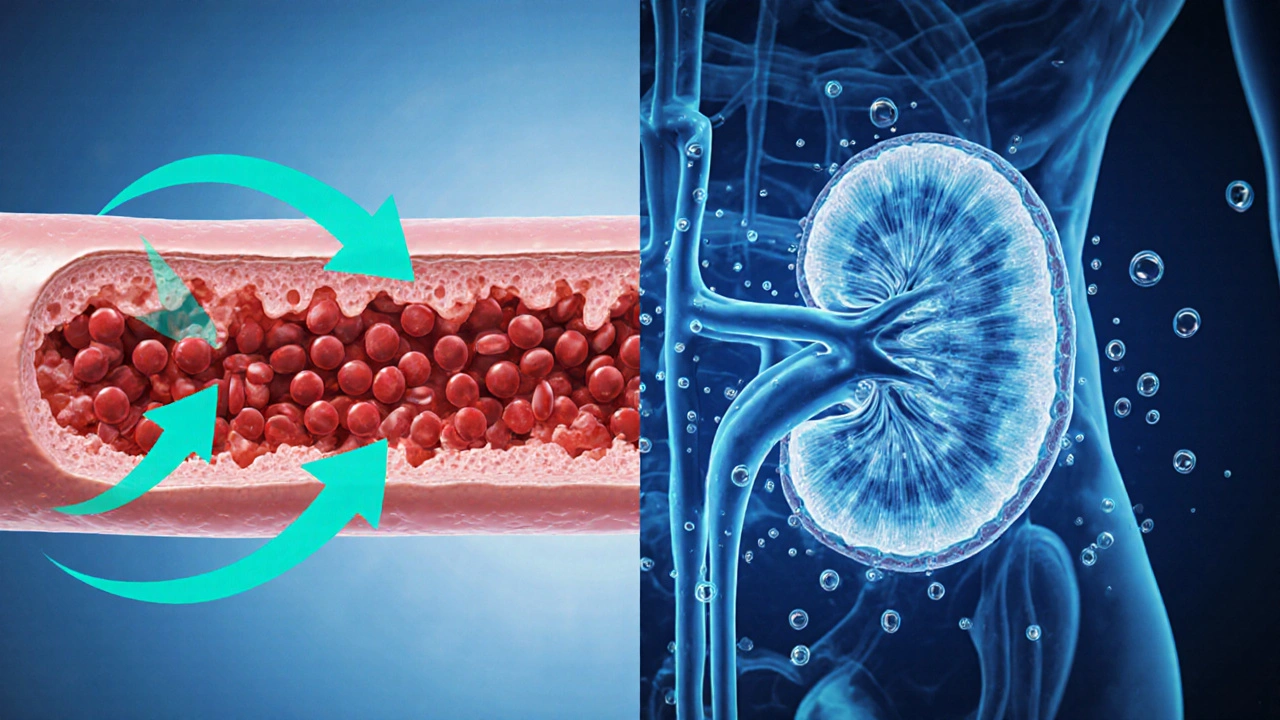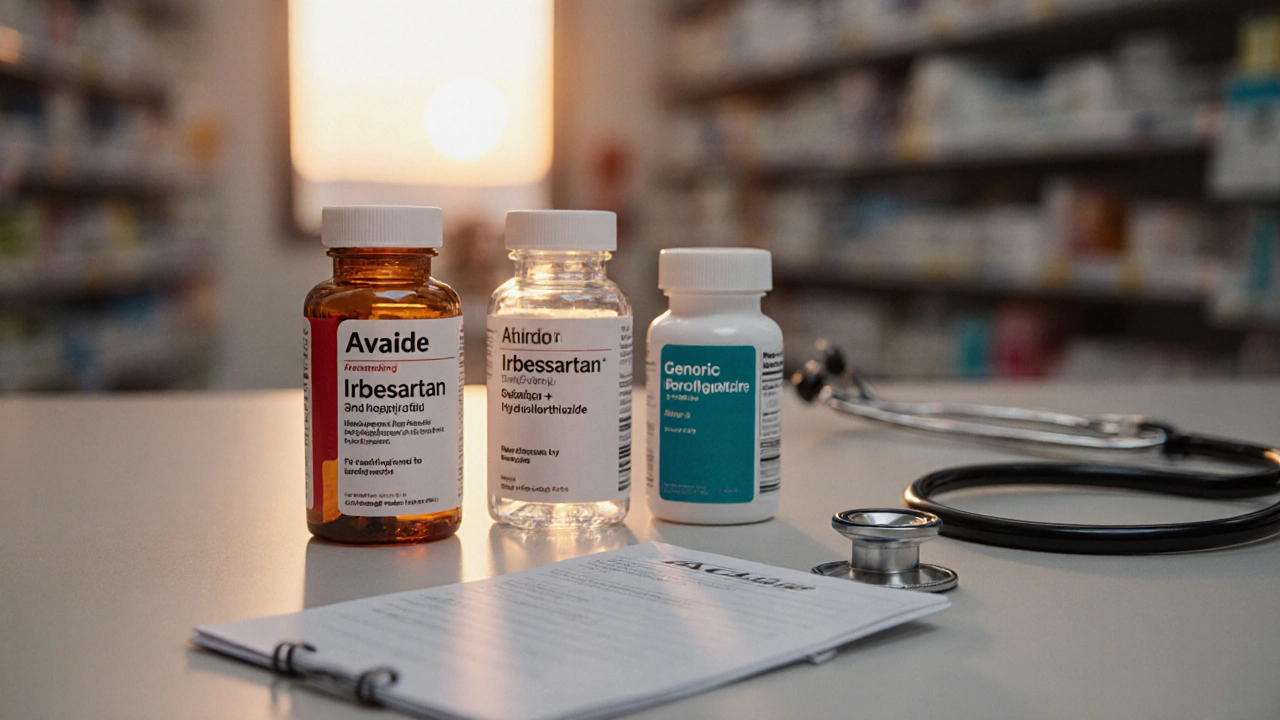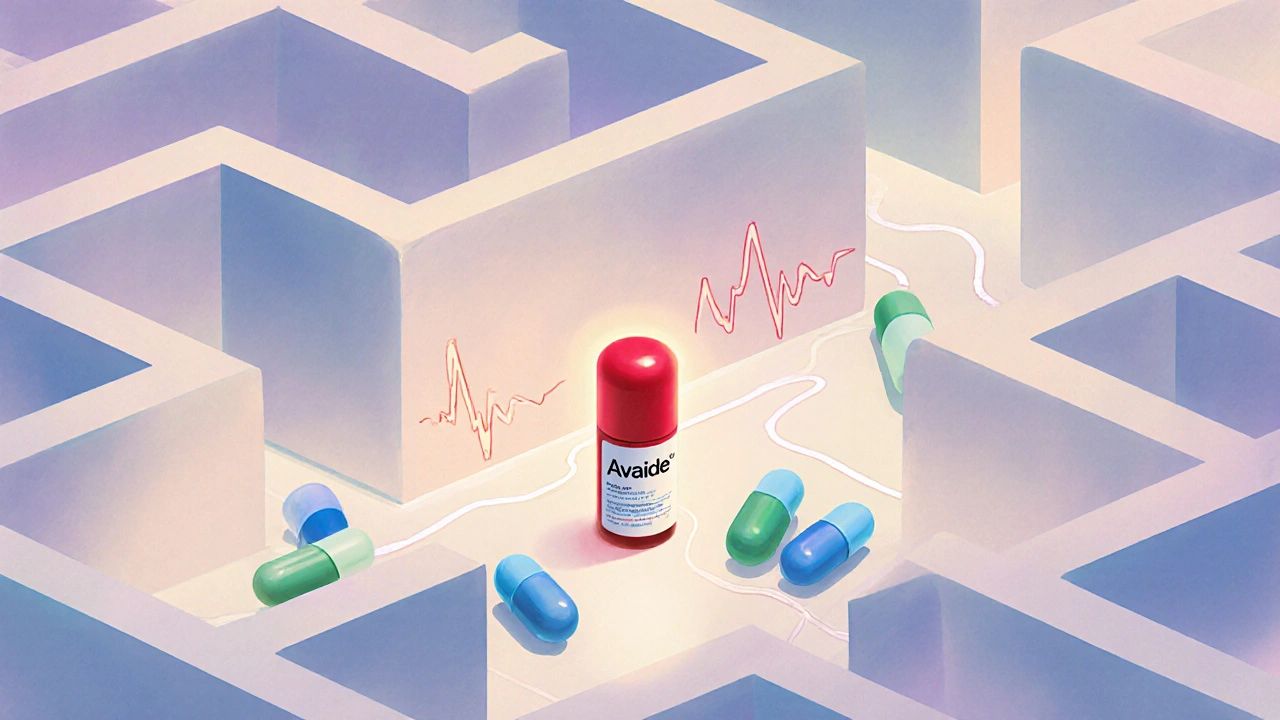Blood Pressure Drug Comparison Tool
Avalide (150mg/12.5mg)
Side Effects: Dizziness, low K+, increased urination
Cost: $30-$45/month
Pills per day: 1
Irbesartan (150mg)
Side Effects: Dizziness, hyperkalemia (rare)
Cost: $20-$25/month
Pills per day: 1
Losartan + HCTZ (50mg/12.5mg)
Side Effects: Similar to Avalide
Cost: $28-$35/month
Pills per day: 2
Lisinopril (10mg)
Side Effects: Cough, angio-edema, high K+
Cost: $15-$20/month
Pills per day: 1
Telmisartan (80mg)
Side Effects: Dizziness, mild K+ rise
Cost: $25-$30/month
Pills per day: 1
Key Decision Factors
- Need for Diuretic? If you have fluid retention or swelling, combo drugs like Avalide may be preferred.
- Dry Cough Sensitivity? ARBs (like Avalide) are often better choices than ACE inhibitors like Lisinopril.
- Cost Considerations? Generic components can be less expensive when bought separately.
- Kidney Health? Some ARBs are gentler on kidneys than ACE inhibitors, but monitoring is still important.
- Dosing Simplicity? Avalide, Telmisartan, and Valsartan offer once-daily dosing with just one pill.
Quick Summary
- Avalide combines Irbesartan (an ARB) with Hydrochlorothiazide for added diuretic effect.
- Most alternatives are either single‑component ARBs or ACE inhibitors.
- Cost, side‑effect profile, and dosing convenience are the main decision points.
- Patients with kidney issues may prefer ACE inhibitors; those needing stronger fluid removal may stick with Avalide.
- Always discuss any switch with a healthcare professional to avoid unwanted blood‑pressure spikes.
Finding the right blood‑pressure pill can feel like a maze. You might have heard of Avalide and wonder if cheaper or simpler options exist. Below you’ll get a straight‑talk comparison that lets you see where Avalide stands, what the main alternatives are, and which factors really matter when you or your doctor choose a medication.
What is Avaline?
Avalide is a combination tablet that merges Irbesartan, an angiotensinII receptor blocker (ARB), with Hydrochlorothiazide, a thiazide‑type diuretic. It was first approved in the early 2000s and is marketed for treating high blood pressure (hypertension) when a single drug isn’t enough. By hitting two pathways at once-blocking the hormone that tightens vessels and nudging the kidneys to shed excess fluid-Avalide often achieves target pressures faster than an ARB alone.
How Avalide Works
Irbesartan blocks the AT‑1 receptors that angiotensinII binds to, preventing the hormone from narrowing blood vessels. Hydrochlorothiazide, on the other hand, tells the kidneys to let more sodium and water out in the urine, lowering blood‑volume pressure. The two mechanisms complement each other, making the combo especially useful for patients whose blood pressure stays high despite a single medication.

Major Alternatives to Avalide
When you or your doctor consider swapping Avalide, the market offers three broad groups: single‑component ARBs, other ARB‑plus‑diuretic combos, and ACE inhibitors.
- Irbesartan is the ARB part of Avalide, sold as a standalone tablet in doses from 75mg to 300mg. It lacks the diuretic effect, so you may need an extra pill for fluid control.
- Hydrochlorothiazide is the thiazide diuretic component. It’s often paired with other ARBs or ACE inhibitors in fixed‑dose combos.
- Losartan is another ARB that comes in 25mg‑100mg tablets. Like Irbesartan, it blocks AT‑1 receptors but has a slightly different side‑effect profile.
- Valsartan is an ARB popular for heart‑failure patients as well as hypertension. Doses range 40mg‑320mg, and it’s sometimes combined with Hydrochlorothiazide.
- Telmisartan offers a longer half‑life than many ARBs, allowing once‑daily dosing up to 80mg. It can be paired with diuretics but is not sold as a fixed combo in most markets.
- Lisinopril belongs to the ACE‑inhibitor class. It blocks the conversion of angiotensinI to angiotensinII, lowering pressure through a different pathway.
- Enalapril is another ACE inhibitor, often dosed twice daily. Compared with ARBs, it may cause a dry cough more frequently.
Side‑Effect Snapshot
Side effects are a top reason people switch drugs. Here’s a quick look at the most common complaints for each class.
- ARBs (Irbesartan, Losartan, Valsartan, Telmisartan, Candesartan): headache, dizziness, rare hyperkalemia.
- ACE inhibitors (Lisinopril, Enalapril): dry cough, angio‑edema, elevated potassium.
- Thiazide diuretics (Hydrochlorothiazide): increased urination, low potassium, mild rise in blood sugar.
Because Avalide mixes an ARB with a diuretic, it inherits side effects from both, but many patients tolerate the combo well.
Cost and Convenience
Price is a practical hurdle. Generic Irbesartan and Hydrochlorothiazide are each cheap, but buying them separately adds a pill count. A single Avalide tablet can be a bit pricier per milligram, yet the convenience of one pill daily often outweighs a small cost bump.
| Drug (dose) | Class | Mechanism | Typical Side Effects | Monthly Cost (AU$) | Pill Count per Day |
|---|---|---|---|---|---|
| Avalide (150mg/12.5mg) | ARB+Diuretic | AT‑1 blockade + sodium‑water excretion | Dizziness, low K+, increased urination | ≈$30‑$45 | 1 |
| Irbesartan (150mg) | ARB | AT‑1 blockade | Dizziness, hyperkalemia (rare) | ≈$20‑$25 | 1 (+ optional diuretic) |
| Losartan (50mg) + Hydrochlorothiazide (12.5mg) | ARB+Diuretic | Same as Avalide, different ARB | Similar to Avalide | ≈$28‑$35 | 2 (if separate) |
| Lisinopril (10mg) | ACE inhibitor | Blocks Ang I → Ang II conversion | Cough, angio‑edema, high K+ | ≈$15‑$20 | 1 |
| Telmisartan (80mg) | ARB | AT‑1 blockade, long half‑life | Dizziness, mild K+ rise | ≈$25‑$30 | 1 |

Choosing Between Avalide and Its Alternatives
Here’s a quick decision tree you can run through with your doctor:
- Do you need a diuretic? If labs show excess fluid or swelling, a combo like Avalide or a separate Hydrochlorothiazide makes sense.
- Do you experience a dry cough on ACE inhibitors? If yes, an ARB (Irbesartan, Losartan, etc.) is a better fit.
- Is cost the main barrier? Generic Irbesartan + Hydrochlorothiazide may shave a few dollars off each month.
- Do you have kidney disease? Some ARBs are gentler on the kidneys than ACE inhibitors; however, dosage adjustments are often required for all renally‑cleared drugs.
- Are you after once‑daily simplicity? Avalide, Telmisartan, and Valsartan offer true once‑daily dosing without extra pills.
Every point above translates into a conversation with your prescriber. Bring lab results, insurance details, and a list of any side effects you’ve noticed.
Practical Tips for Switching or Starting a New Regimen
- Never stop a blood‑pressure drug abruptly-risk of rebound hypertension is real.
- If moving from Avalide to separate components, keep the same total daily dose unless your doctor says otherwise.
- Monitor blood pressure daily for the first two weeks after any change; note any dizziness or swelling.
- Ask about potassium‑rich foods if you’re on an ARB or ACE inhibitor; high potassium can cause cardiac issues.
- Schedule a follow‑up blood test in 4‑6 weeks to check kidney function and electrolytes.
Frequently Asked Questions
Can I take Avalide with other blood‑pressure pills?
Usually no. Adding another ARB or ACE inhibitor can over‑suppress the renin‑angiotensin system and raise the risk of low blood pressure or kidney problems. If your doctor wants extra control, they’ll likely add a calcium‑channel blocker instead.
Is the diuretic part of Avalide necessary for everyone?
Not always. Patients without fluid overload can manage with Irbesartan alone. However, many clinicians keep the diuretic because it adds a modest extra drop in systolic pressure without a lot of extra hassle.
What should I watch for when switching from Avalide to an ACE inhibitor?
Watch for a persistent dry cough, facial swelling, or a sudden rise in blood pressure. ACE inhibitors can also raise potassium levels, so a blood test after two weeks is wise.
Are there any drug interactions I need to know about?
Both the ARB and the thiazide can boost potassium‑sparing effects of potassium supplements or certain heart‑failure drugs. NSAIDs (like ibuprofen) can blunt the blood‑pressure‑lowering effect and stress the kidneys.
How long does it take to see the full effect of Avalide?
Most patients notice a drop in systolic pressure within a week, but the maximum effect can take 2‑4 weeks as the body adjusts to the diuretic component.
Bottom line: Avalide offers a convenient, proven combo for many folks dealing with stubborn hypertension, but it isn’t the only path. By weighing cost, side‑effect tolerance, and dosing preferences, you can land on the option that fits your lifestyle and health goals.





Andrea Jacobsen
October 10, 2025 AT 17:14I appreciate the thorough breakdown; it really helps people compare the combo pills without feeling overwhelmed.
Andrew Irwin
October 11, 2025 AT 21:00Totally agree, the side‑effect table makes it easy to see why someone might pick a single ARB over a combo.
Jen R
October 13, 2025 AT 00:47Honestly, the article is spot on, but I’d add that many patients end up paying more for the brand combo when generic separate pills are just as effective.
Joseph Kloss
October 14, 2025 AT 04:34When you look at the pharmacology, combining an ARB with a thiazide isn’t just about convenience; it’s a strategic convergence of two physiological pathways. The ARB blocks the angiotensin II receptor, preventing vasoconstriction, while the thiazide nudges the kidneys to excrete sodium and water, lowering plasma volume. This dual action can produce a synergistic drop in systolic pressure, often more than the sum of its parts. However, the synergy also means you inherit the side‑effects of both classes, so clinicians must monitor electrolytes closely. Potassium levels can swing upward because the ARB reduces aldosterone‑driven potassium excretion, while the thiazide can cause hypokalemia; the net effect varies per individual. Moreover, the diuretic component can trigger a modest rise in blood glucose, which matters for patients with pre‑diabetes. Another subtle point is the impact on uric acid; thiazides can increase serum uric acid, potentially aggravating gout. From a cost perspective, the fixed‑dose combo is sometimes pricier than separate generics, but the savings in pill burden can improve adherence. Adherence is a huge factor; one pill a day reduces the chance of missed doses compared to juggling multiple meds. Still, for patients without fluid overload, the diuretic may be unnecessary, and a plain ARB could be enough. In those cases, physicians often prescribe a low‑dose thiazide separately, tailoring the therapy. The article correctly flags kidney function monitoring, as both ARBs and thiazides can affect renal perfusion, especially in the setting of ACE‑inhibitor or NSAID use. Lastly, the risk of hyperkalemia, though rare, becomes more pronounced if you add potassium‑sparing agents or supplements. So, while the combo is convenient, it’s not a one‑size‑fits‑all solution; individualized assessment remains key.
Cayla Orahood
October 15, 2025 AT 08:20People forget that the diuretic part can expose you to hidden conspiracies like water‑pill surveillance; stay alert.
McKenna Baldock
October 16, 2025 AT 12:07The philosophical angle is that simplicity in medication reflects a desire for a streamlined life; fewer pills can mean fewer decisions.
Roger Wing
October 17, 2025 AT 15:54i think combos are overhyped they just want you to buy more
Matt Cress
October 18, 2025 AT 19:40lol, as if pharma doesn't love a good combo pack – just kidding, but seriously, the cultural shift toward single‑pill regimens is real.
Andy Williams
October 19, 2025 AT 23:27Grammar note: "combination" should be singular when referring to Avalide as one tablet, not "combinations".
Paige Crippen
October 21, 2025 AT 03:14Make sure you aren't being tracked by the manufacturers through your prescriptions.
sweta siddu
October 22, 2025 AT 07:00Great info! 🙌 I’m especially curious about the cost differences when using insurance vs. cash. 😊
Ted Mann
October 23, 2025 AT 10:47From a philosophical standpoint, the choice of medication mirrors the balance between control and freedom in our lives.
Brennan Loveless
October 24, 2025 AT 14:34Honestly, anyone can read the table and make a decision; no need for a grand narrative.
Vani Prasanth
October 25, 2025 AT 18:20Supportive tip: discuss these options with your pharmacist too; they often have practical insights on refill timing.